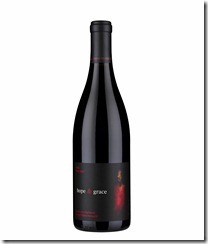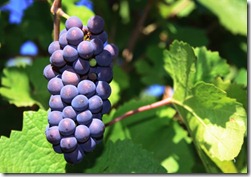I professed my love to Cabernet Sauvignon on September 1st this year, (Facebook can prove it) but the next day I had an affair with Pinot Noir…
Pinot has always been there with its approachable, fruit-forward, and fleshy (sometimes even a little dirty) self; my only complaint about this cherished varietal is the deviations. From season to growing-region, winemaker, vineyard, row and clone the possibilities are endless… maybe that’s part of the reason I like it so much…
In a quest to understand this desirable creature, I had to opportunity to learn about it from vine to wine with Andy Mitchell, our Pinot Noir grower in the Santa Lucia Highlands, and Charles Hendricks, our very own winemaker at hope & grace wines. Andy Mitchell, the vineyard manager for the Hahn estate, grows the fruit for our signature wine, the hope & grace Santa Lucia Highlands Pinot Noir… He and Charles worked together in selecting 3 clones for this wine… (Drumroll please)… May I introduce the Swan, 777 and Pommard Pinot Noir clones…
Definition in the Oxford Companion by Jancis Robinson: “Clone in a viticultural context is a single vine or a population of vines all derived by vegetative propagation from cuttings or buds from a single ‘mother vine’ by deliberate clonal selection.” This may be to achieve a certain characteristic, promote a clone that is not perceptible to a certain threat or it might just be as Charles so eloquently states, “We are searching for a new clone to plant in what we’ve come to know, from our intergalactic search for other potentially inhabitable planets, as the Goldilocks zone; where everything is just right… or in this case where the clone fits its environment.”
The following questions were very generically asked to both Charles and Andy and here are a few of their answers… (I offer my opinion too, no need for worry)
Any thoughts on today’s Pinot Noir clones?
Charles Hendricks: “When we talk of Pinot Noir clones it’s a number stew. Each clonal selection, usually from the French viticulture development and selection is assigned a number. Some of the early ones started as 103, then 105. They moved onto 115, then 667, 777, and now the numbers are somewhere in the 800’s. It takes time to see how these new clones play out in the climate of California. Remember, these were selected in cooler France, not sunnier California. We had to wonder…Will the fruit drop its acidity too soon, and leave a ho-hum boring flavor? Or will it be zippy and racy?”
Let’s get to specifics, what about the Swan clone can you tell me?
Charles Hendricks: “There was Pinot Noir before the numbers game began. Individuals selected material from their own vineyards or brought back material from their travels abroad. The more promising stayed in use, and got planted by more growers. Conversations could be had about the success or failings of these clones. Joseph Swan, an early pioneer in Pinot, made such a selection, and the success of the material came to bear his name. The ‘Swan’ clone stands up to the heat of California, and produces a wine with a finely scented bouquet. It doesn’t have much color, but then again some of the best Burgundies look like rose.”
Andy Mitchell: “The Swan clone is one of the more fragile Cholera clones and it can have some virus issues as it is a smaller berry with a thinner skin making it more susceptible to sunburn. It also does not need as much stress as an already delicate and low yielding clone with minimal drought tolerance.”
What about 777 (pronounced ‘Triple 7’)?
Charles Hendricks: “After some discussion, we took a chance on 777. It is much denser than the other two, and we like because it is said to add backbone to wine. This is exactly what it did for hope & grace. It is a bit of a late bloomer in the barrel but by bottling time, it smoothed out and beautifully integrated in the blend. It is a great component clone.”
Andy Mitchell: “The 777 much darker in color. It stems from the Dijon clones in variation and has been known to add a dark, rich and velvety characteristic to the wine.”
Why Pommard? (I also asked Andy where it was on the property and what’s going on in the vineyard…)
Charles Hendricks: “Another early selection was the Pommard clone; you can guess its origins. Pommard, for me, is the wine brut of Burgundy. It has none of the ethereal charms of a Musigny, or Romanée-Conti. It does, however, have a rich density and color. I don’t really enjoy French Pommard, but bring it to California and it does wonderful things. If I had one stand-alone clone to make, this would be it. It has the power and weight, but, also, it has great depth of fruit.”
Andy Mitchell: ‘The Doctor’s Vineyard is a 400 acre parcel with 80% planted to Pinot Noir. The F Block where the hope & grace fruit is sourced is the 3 clones(Swan, 777 and Pommard) on a non-drought tolerant 5C rootstock. The block is on an ancient alluvial fan which is extremely well drained but can also act as a reservoir on the Santa Lucia Highlands bench. Of the three clones, the Pommard is the clone of choice by all winemakers and it just flourishes in this spot. It can be a touch meaty but always has these beautiful intense and pure fruit characteristics. In the vineyard right now, everything is almost dormant and we are getting ready to prune so we can anticipate budbreak in March.”
Why all three? How did you get there? (I know what you are thinking… I am a great interviewer!)
Charles Hendricks: “With this little history, we tried to make an informed decision of what clones hope & grace wines would like to source from the Hahn Estate in the Santa Lucia Highlands. I had worked with several of the new numbers, and wanted a third to flesh out our Pinot. Most of the other numbered clones produced an overlap of the characteristics that I found in the Pommard and Swan selections. So we decided to add the 777 as our third to round out the wine and add a new dimension to the structure. For three vintages now, we blended all three clones to produce our Santa Lucia Highlands Pinot Noir. Each clone has played beautifully off the other. This is why, I believe, our Pinot has the lushness, the fruit, and the density that it does. These pinots have the staying power of the great wines of Burgundy. Enjoy them now, or don’t. They’ll be there when you’re ready.”
Thank you Andy and Charles!
 2008 hope & grace Santa Lucia Highlands Pinot Noir
2008 hope & grace Santa Lucia Highlands Pinot Noir
I now know why growers and winemakers can refer to Pinot Noir as the “heartbreaker”. This thin-skinned, delicate varietal needs everything just right… I am thrilled we have such an experienced grower and winemaker who have done their homework, taken the time and put in the hours to make sure that Goldilocks liked her porridge… if you haven’t tasted our Pinot Noir you really should… come by and see us anytime! Cheers!
